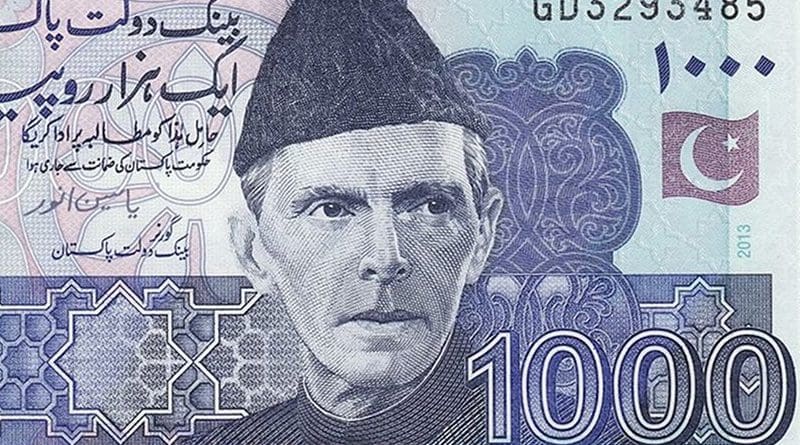Fall In Rate Of Pakistan’s Rupee Posing Financial Fallout For Its Users In Afghanistan – OpEd
By Hamayun Khan
Pakistan’s Rupee has been circulating in eastern and southeastern markets of Afghanistan since Dr. Najeebullah’s Government has been overthrown and the then civil turmoil in the country. Over the last five years, the sprint in the slowdown of Pakistan’s economy, which caused its currency to depreciate in the international market, has badly affected the local businesses in the eastern and south-eastern Afghanistan.
To avoid further loss, the local marketers along with concerned authorities requires taking up earnest control measures for the stoppage of Rupee’s depreciation through concerted actions. Ordinary lives, marketers, and the financial system of Afghanistan will be negatively affected if otherwise neglected.
Impact of rupee depreciation on various businesses and the ordinary lives
Impact on local vendors and shopkeepers
A jeweler who used to sell a single piece of a locket for Rs50, now due to the depreciation in the rate of Rupee costs the vendor Rs70. To gain profit, the vendor sells the same item in the range of Rs80 to Rs90, therefore the seller losses costumers due to the increased rate of inflation.
A tailor working as a trainee in a tailoring shop, when interviewed expressed that due to the Rupee’s devaluation he is not able to afford his house expenses, due to the fact that he including other trainees are paid the same salary as they were being paid earlier, but on the other hand the prices are going high in the market with the decrease in the value of Rupee. Therefore, it has proven to be challenging for them to support the family with such amount of salary.
According to a shopkeeper, the devaluation in the rate of Rupee has not only inflamed inflation in the market, but has also led to customers distrusting products.
In other countries the prices of the products are lowered and provide various discounts and offers to the customers during the festivals i.e. (Eid and Christmas), whereas in the case of Afghanistan the scenario is utterly opposite, during festivals in the markets of Jalalabad in particular, the prices go sky high as compared to the ordinary days, this practice is thought to be a major hindrance for the marketers to attract customers.
Impact on general public and transport drivers
Depreciation in the rate of Rupee has posed a huge economic hitch for the general public and considered to be a financial crisis for the people of Jalalabad. Because the slump in the value of Rupee compels them to buy a tiny item at a higher price than its ordinary price. For instance, the credit card priced only AFN 50 which costs Rs100, but after the value of Rupee has decreased customers have to pay AFN50 with Rs10 extra.
An ordinary jobless citizen or one having a job with a low salary is in dilemma whether to spend the earned rupees or not, if they receive the same amount of salary in rupee or save it for meeting the future needs there will be possible future economic complications in case the rate of rupee slumps. The Afghani is considered as a sacred currency by many of the businessmen and residents of Jalalabad, “our currency showcases our Identity, sovereignty, and economic self-dependence, but we the Afghans have disgraced it by prioritizing Rupee over Afghani and made Rupee our daily transactional currency, this is the main reason that our people nowadays witness various financial hitches as the Rupee’s value downslides” said an elder residing across the Jalalabad City.
“If Rupee is banned, items that are sold at Rs100 would be sold at AFN 50, if this happens all the items will be priced half of the current prices, and this way both the rate of Afghani will be increased in the international market, as well as businesses and the general public will be rescued from Rupee’s fallout,” said a school teacher.
The government has placed banners and bulletin boards across the city displaying that Afghani is our national identity, well, it is crystal clear and well understood by everyone, but what exactly people need is to know the blueprints of how to put an end to the use of Rupee. This is the demand of every citizen of Jalalabad city.
Several rickshaw drivers when asked, called upon the Ministry of Finance (MoF) of Afghanistan to take earnest measures to halt the use of the Rupee in the regions located in the narrow area of the Durand line, particularly in the Nangarhar.
The Central Bank of Afghanistan (Da Afghanistan Bank) could halt the circulation of Rupee by printing new Afghani notes, which would be thus exchanged with Rupee and the old notes by the local banks across Nangarahar and southeastern Afghanistan up to a specified time limit.
The shopkeepers and marketers, should stop selling their products on Rupee and replace it with Afghani so that the customers will be compelled to slowly put an end to the use of Rupee.
The Ministry of Finance of Afghanistan (MoF) should outline a special law for the currency exchange tellers and the money market so that this way the open money market will be shunned and the extent of foreign currencies to Afghanistan will be confined to a specified level.
*Hamayun Khan is from Afghanistan and currently pursuing last year of an MBA at Punjab Technical University, India.

